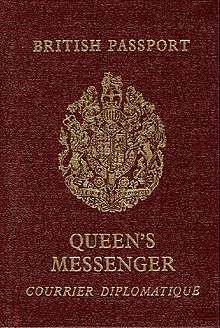Queen's Messenger
The Corps of Queen's Messengers are couriers employed by the British Foreign and Commonwealth Office. They hand-carry secret and important documents to British embassies, high commissions, and consulates around the world. Many Queen's Messengers were retired Army personnel. Messengers generally travel in plain clothes in business class on scheduled airlines with their consignment.


The safe passage of diplomatic baggage is guaranteed by the Vienna Convention on Diplomatic Relations, and for reasons of state secrecy, the diplomatic bag does not go through normal airport baggage-checks and must not be opened, x-rayed, weighed, or otherwise investigated by customs, airline security staff, or anyone else for that matter. The bag is closed with a tamper-proof seal and has its own diplomatic passport. The Queen's Messenger has the status of a diplomatic courier and cannot be detained. However the messenger and the messenger's personal luggage go through normal security screening.
History
The formal role and title ‘Royal Messenger’, whether to King or Queen, is most certainly evident within the retinues of English Monarchy, certainly extending back to the early 12th Century.
Suggested reference: ‘King's Messengers 1199-1377: A List of All Known Messengers, Mounted and Unmounted, who Served John, Henry III, and the First Three Edwards', by Mary C. Hill.
The abstract of Mary Hill’s book reads "The work of the king's messengers, bearing important messages to all parts of the realm and overseas, was vital to the government of medieval England ... Deservingly, the best messengers were well rewarded in service and retirement. Styled 'Nuncii' or 'Cursores' to distinguish horsemen and runners, they were familiar figures about the royal household, and were often known by distinctive nicknames. Mary Hill has succeeded in identifying, from Wardrobe and Exchequer accounts, and other sources, all the messengers for the reigns of John, Henry III, and the first three Edwards. They are presented in alphabetical order with a service record for each man, commentary and references. This study constitutes an important and valuable resource for all those interested in administrative, court or postal history for the period 1199-1377"
A noted 15th Century King's Messenger was John Norman, who was appointed in 1485 by King Richard III to hand-deliver secret documents for his monarch. During his exile, Charles II appointed four trusted men to convey messages to Royalist forces in England.[1] As a sign of their authority, the King broke four silver greyhounds from a bowl familiar to royal courtiers, and gave one to each man. A silver greyhound thus became the symbol of the Service.[1] On formal occasions, the Queen's Messengers wear this badge from a ribbon, and on less formal occasions many messengers wear ties with a discreet greyhound pattern while working.
Modern day
.jpg)
Modern communications have diminished the role of the Queen's Messengers, but as original documents still need to be conveyed between countries by "safe-hand", their function remains valuable, but declining.
In 1995 a Parliamentary question[2] put the number of Messengers then at 27. The number in March 2015 was sixteen full-time and two part-time, and the departmental headcount was nineteen.[3] In December 2015 an article in the Daily Express suggested that the Queen's Messenger service was "facing the chop by cost-cutting Foreign Office mandarins who see them as a legacy of a by-gone age".[4]
The British Rail Class 67 diesel locomotive 67005 bears the name Queen's Messenger.
See also
- Diplomatic courier
- BSAA Star Dust was carrying a King's Messenger at the time of its disappearance
- SS Berlin was carrying a King's Messenger at the time of its sinking
References
- Mitchell, Keith (25 March 2014). "The Silver Greyhound - The Messenger Service". GOV.UK. Retrieved 18 September 2015.
- "Hansard". UK Parliament. Retrieved 17 April 2015.
- Freedom of Information Act 2000 Request Ref: FOI Ref: 0315 Letter from Foreign & Commonwealth Office, dated 27 April 2015
- Giannangeli, Marco (5 December 2015). "Queen's Messengers face the axe, heroes who resisted all tyrants, honeytraps and pirates". Daily Express. Retrieved 7 September 2016.
Further reading
- Antrobus, George Pollock, and Cecil Hunt. King's Messenger, 1918-1940, Memoirs of a Silver Greyhound. London: H. Jenkins, 1941.
- Bamber, Iain. From Pouch to Passport: A History of Kings & Queens Messenger Insignia. Mandurah, W.A.: DB Publishing, 2009.
- O'Brien-Twohig, Michael. Diplomatic Courier. Elek Books, 1960.
- Wheeler-Holohan, Vincent. The History of the King's Messengers. London: Grayson & Grayson, 1935.
External links
- Queen's Messenger Story 1952, British Pathe film, 7:42 mins. Can be viewed online